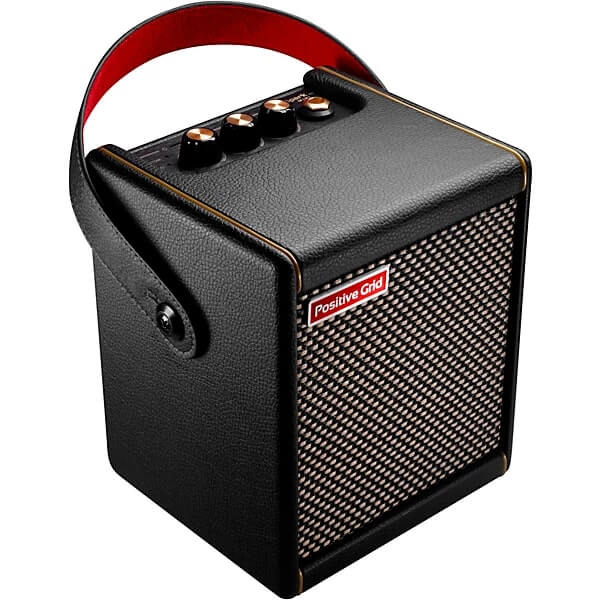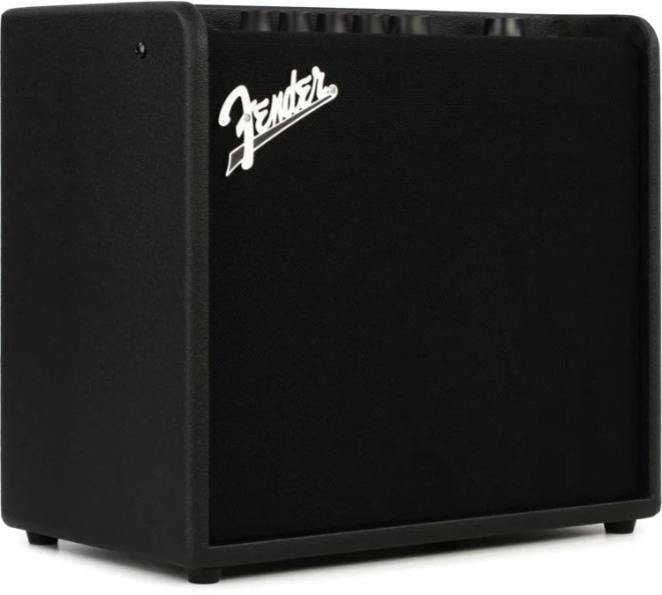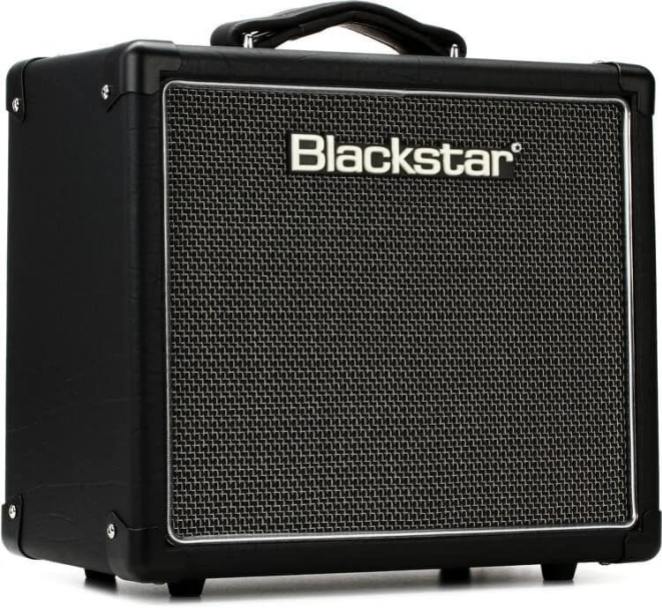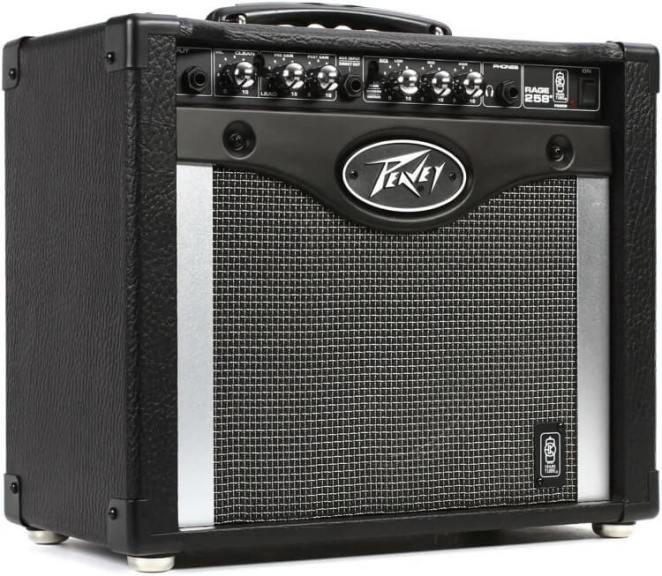When you buy through our links, we may earn an affiliate commission.
So you've decided to take up guitar playing! Give yourself a pat on the back already since the guitar is one of the most versatile, widely appealing, and rewarding instruments you can learn.
No doubt you've put some thought into picking the right guitar for you but choosing the best guitar amp is just as important—if not more important!
Without the right amp for your needs, you may be unable to achieve the tone, volume, or playing style that inspired you to pick up the guitar in the first place. This is why amp selection is so important for ambitious new guitar players.
Picking just one amp out of the vast number available can be a daunting task, but fortunately, there are tons of amazing, fully-featured options out there. This article includes the seven best amps for beginners, as well as a buyer's guide and FAQ section so you know exactly what to look out for.
Our number one choice, the Orange Crush 20, makes it easy and affordable to dial in a beautiful tone for practicing, jamming, and even gigging.
Enjoy these picks for the best beginner amps, and pick one up today so you can get straight to playing.
Quick Summary of the Best Amp for Beginners
- Orange Crush 20 (Best Overall Amp for Beginners)
- Positive Grid Spark Mini (Best Beginner Desktop Amp)
- Boss Katana 50 MkII (Best Beginner Gigging Amp)
- Fender Mustang LT25 (Best Beginner Amp for Recording)
- Blackstar HT-1R MkII (Best Tube Amp for First-Time Buyers)
- Vox Pathfinder 10 (Most Convenient Beginner Practice Amp)
- Peavey Rage 258 (Best Clean Tone)
Best Amp for Beginners
1. Best Overall Amp for Beginners – Orange Crush 20

SPECS
- Type: Solid State
- Total Power: 20 Watts
- Price: $149.99
With all-analog circuitry, a simple, portable design, great sound, and surprising versatility, the Orange Crush 20 allows for a true "plug and play" experience. It will help you focus on developing your sound as a guitarist rather than your skill as an amp user.
Instead of pummeling you over the head with a torrent of preset tones and effects like many other beginner amps, the Crush 20 offers just two channels: clean and dirty.
Between these two channels, you're able to produce anything from sparkling cleans and subtle crunch to chunky overdrive and bleeding metal tones.
The lack of options may seem like a disadvantage, but in our experience, it's actually a huge plus. You'll be able to spend less time playing around with the amp and more time actually playing guitar while still achieving great sound. Orange calls it "playing the instrument, not the technology." We think that's perfectly apt.
The Crush 20 includes onboard reverb and a three-band EQ, allowing you to color your sound and add some atmosphere and texture. There's also an onboard tuner, a convenient feature we would never want to live without.
While you won't be using this amp for huge gigs, the 20 watts of power is quite loud and is more than enough power for smaller venues.
If you go to your local music shop and play around with a handful of different amps, you may find that there's something about Orange amps that just feels different. More responsive, louder, more in-your-face (in a good way).
Guitarists call this "the Orange sound," and it's part of what's made these amps so coveted for decades. They have a slightly different sound than other brands do, and it's a sound a lot of guitarists tend to like. It particularly appeals to fans of high-energy music because of its well-defined mid-high end and grittiness.
Best of all, the Orange sound is just as enticing to beginners as it is to pros because you know what you're getting. When you're just starting out, it is much better to be able to achieve a dependable tone quickly rather than spending all your time making minor adjustments.
All in all, the Orange Crush 20 is a fantastic beginner guitar amp because of its high-quality tones and superb usability. We couldn't recommend this amp highly enough.
2. Best Beginner Desktop Amp – Positive Grid Spark Mini

SPECS
- Type: Solid State Stereo
- Total Power: 10W Class D
- Price: $229
The Positive Grid Spark Mini is a small amp, but the tones are huge—and so is the feature set. With eye-popping 10,000 tone presets a digital app, and practice features like chord detection, the Positive Grid Spark Mini wows on all fronts.
With 10 watts of power, you won't exactly be able to play sold-out stadiums with this amp, but it is perfect for practicing at home, jamming in the garage, playing gigs at coffee shops, or just annoying your neighbors.
As a solid state digital modeling amp, the Positive Grid Spark Mini allows you to achieve practically any tone imaginable, from country twang to roaring crunch. With 10,000 presets, there's bound to be something for you, even if you don't feel like creating a tone of your own.
Then there are the practice features. The "Smart Jam Live" feature automatically adds bass and drums to accompany whatever you're playing—you don't even need to set a tempo or key.
A feature called "chord recognition" allows you to import songs onto the app and then view chord charts and changes. A riff training feature allows you to slow down backing tracks and work up to full speed.
These features are not commonly included in amps, and they can actually prove quite useful in cutting down the time it takes to learn new songs and improve your timing chops.
People have a wide range of preferences when it comes to amps. The reason we recommended the Orange Crush 20 - its simplicity - is the opposite of the reason we are recommending the Spark Mini. This amp is perfect for someone who wants all the tone-tinkering options in the world.
While the tones may take longer to dial in, they provide more versatility overall. For just about any tone you've heard on your favorite albums, chances are the Spark Mini can do a decent emulation of it.
The Positive Grid Spark Mini's small footprint means it'll easily fit on a desk, in the corner of your room, or in the car to go wherever you need it. All of this adds up to an amp that excels as a practice companion for beginner guitarists.
If you're looking for a phenomenal beginner guitar amp and want something with a small footprint, the Positive Grid Spark Mini is the amp for you.
3. Best Beginner Gigging Amp – Boss Katana 50 MkII

SPECS
- Type: Solid State
- Total Power: 50W (25W, 0.5W settings)
- Price: $269.99
The Boss Katana 50 MkII is a fantastic amp, and not just for beginners. With 50 watts of power, this amp is easily the loudest on the list.
While the other entries are mostly just suitable for practicing and playing small, intimate shows, the Katana 50 MkII is loud enough for shows with a full band in small to medium-sized venues.
Additionally, the amp includes line-in and line-out ports that enhance its functionality even more. Using these ports, you can take a separate amp and use the Katana MkII to transparently amplify its signal without adding unwanted distortion or artifacts.
Alternatively, you can use the Katana to create the tone you want and then hook it up to a larger speaker system to amplify that tone even more.
With all these features, this Boss amp works seamlessly in gigging and recording scenarios.
But what if you plan to use your amp mostly for practicing? Boss has you covered there, too. With a simple switch, you can scale the amount of power from 50 watts to 25 watts, all the way down to a half watts. This makes the Katana the most versatile amp on the list in terms of volume control.
There's a lot to love about the amp's tone control as well. As a digital modeling amplifier, it is incredibly capable (much like the Positive Grid Spark Mini).
Boss Katana amps do a particularly good job emulating the tube amp sound that many guitarists love (we'll discuss tube amps more later on in the article).
In the software, you can choose between 60 different Boss effects, with up to 15 effects active at once within the amplifier. You can also save up to four preset tones at once and assign them to channels in the amp for easy access.
The Boss internal technology includes eight different electric guitar models and one acoustic guitar emulator. It has a fairly easy-to-use interface for all the tone control it provides.
If you don't mind the slight learning curve relative to simpler amps, then the Katana MkII is an incredibly powerful and multifaceted amp, especially given its price.
If this is the first amp you purchase, then depending on your purposes, it's likely you won't ever need to upgrade.
4. Best Beginner Amp for Recording – Fender Mustang LT25

SPECS
- Type: Solid State with Digital Modeling
- Total Power: 25W
- Price: $159.99
The Fender Mustang LT25 is another impeccable digital modeling amp that packs a lot of tone control into a small package. With this amp, you also get the peace of mind of buying from one of the most time-tested brands in the industry.
Fender tones have remained iconic in classic rock and pop music for years. This amp includes emulations of many classic Fender tones and many other creative tones as well.
With 20 amp models and 25 built-in effects, as well as tons of adjustable parameters, this amp will allow you to dial in whatever tone you might be looking for on your next project.
Although you can totally play small gigs with this amp, we recommend it more for recording rather than gigging. If you intend to play a lot of shows, the high wattage of the Boss amp or the simplicity of the Orange amp might serve you better.
The Fender Mustang LT25 does have a sleek user interface, though, as well as features that are specifically useful for recording. With a built-in tuner and a tap tempo button for modifying time-based effects like delay, you can easily get your playing to sound perfect for the recording.
The built-in USB port allows you to connect the amp straight to your DAW, which makes it a versatile tool for song production.
There are two ways to record guitar: direct input (DI) and miking your amp. If given the option, studio recording engineers always prefer to use both of these techniques at once to record guitar parts so that they have more sound information to work with.
With this amp, you can record your guitar parts directly into your DAW, even if you don't have an audio interface. And if you do have one, then you can mic the amp up as well.
Two types of recording will enable you to make your guitar parts sound fuller and more well-rounded in the mix. You can keep all the tone characteristics you want and cut the ones you don't.
The Fender Mustang LT25 is a thrilling amp to experiment around with. Few other amps manage to pack so much tone control into such a simple interface.
5. Best Tube Amp for First-Time Buyers – Blackstar HT-1R MkII

SPECS
- Type: Tube amp
- Total Power: 1W
- Price: $319.99
Most first-time buyers will not want a tube amp, but if you do want to go the tube route, then the Blackstar HT-1R MkII is a great beginner guitar amp.
Let's briefly go over the difference between tube and solid state amps and why tube amps are less often recommended for new players.
Tube amps came first and used hollow glass tubes, or valves, to amplify the electrical signal that comes from the guitar. Solid state amps, on the other hand, use transistors and circuits to amplify the signal.
So, what does this mean in practical terms? It's almost like driving stick-shift vs. automatic. It is more practical and efficient to drive automatic, but some car lovers just prefer the feel of a stick shift.
Likewise, while tube amplifiers necessitate more upkeep and setup than solid state amplifiers, many guitarists specifically prefer the feel and tone of tube amps.
We usually recommend solid state amps for beginners because they are less breakable, less heavy, and generally simpler to use.
It just comes down to preference, though, and if you're already familiar with the tube vs. solid state debate and find yourself on the side of tube amps, then this is the one you should buy.
Don't let the "1 Watt" of power scare you away; tube amps require significantly less power than solid state amps, so the Blackstar HT-1R MkII is able to pack a pretty loud punch all on its own.
Tube amps are known for their vintage sound and this amp packs that sound into a modern package. You can get the genuine tube tone and feel and even plug in a USB to record the sound straight to your computer. Who doesn't love classic guitar sensibility with a modern twist?
While you can't achieve as many tones as you could with a digital modeling amp, you do get access to a handful of clean tones and distorted/overdriven tones that have the warmth and roundness tube amp fans are looking for. It's quality over quantity with the Blackstar HT-1R MkII.
6. Most Convenient Beginner Practice Amp – Vox Pathfinder 10

SPECS
- Type: Solid State
- Total Power: 10W
- Price: $109.99
A 10-watt solid state amp that's only 10 pounds? What's not to love?
The Vox Pathfinder 10 is one of the most potable guitar amps on the market, and at barely over $100, it's a great choice for beginners who just need a practice amp. The Vox delivers extreme cost-efficiency and simplicity.
As the most budget-friendly amp on this list, it is a good introductory amp, but it lacks certain features that the other pricier ones have. Most notably, there is no built-in reverb, so you may eventually want to get a reverb pedal or some other kind of multi-FX pedal to go along with it.
It does have a clean/overdrive switch, EQ controls, and a distinctive Vox tone. This amp's versatility comes not from its tone control but from the fact that it can easily accompany you wherever you go.
If you want a low-investment introduction to the world of guitar, one that will let you practice hassle-free and explore what you like about the instrument, then the Vox Pathfinder 10 is a great choice for you.
However, if you plan to play gigs or do some recording, then you'll probably want to go with an amp that is louder and more feature-rich.
7. Best Clean Tone – Peavey Rage 258

SPECS
- Type: Solid State
- Total Power: 25W
- Price: $149.99
Peavey is yet another brand with a long history of satisfied buyers. Musicians across all different styles and budgets can almost always seem to find a Peavey product that will work for them. This cost-effective amp is no exception. Introducing the Peavey Rage 258.
As a solid state amp with TransTube tube emulation circuitry, the Rage 258 very closely approximates a tube amp sound while still having the durability and efficiency of a solid state amp.
There isn't much onboard support for players who want a heavily distorted tone, but when to clean tones, this amp really shines.
Rich, warm, full, well-rounded—the tone sounds beautiful right from the very first strum. While the amp lacks built-in effects like delay or tremolo, the tone itself is highly customizable.
Choose from three amp presents - stack, modern, or vintage - and make adjustments with the three-band EQ, pre and post-gain dials, and clean/lead tone switch.
25 watts is a decent amount of power for this price point, and you'll have no trouble using this amp to practice, jam, or play shows for small crowds.
We recommend the Peavey Rage 258 to fans of blues, country, jazz, classic rock, or anything that calls for a beautiful, vintage-sounding, clean tone.
Best Amp for Beginners Buyer's Guide
The reality is there's no one perfect beginner guitar amp. But there is that one amp that will be perfect for your specific needs.
This beginner guitar amps guide will tell you the most important aspects of guitar amps so that you can find one that suits your personal style, budget, and purpose.
Type of Amp
There are two types of ways to amplify your guitar: an amp head and cabinet or a combo amp. With an amp head and cabinet, the preamp that handles the attenuation and modulation of the guitar signal exists as its own unit, while the cabinet is a separate unit that just contains the speaker.
Many professional musicians and audio technicians prefer the head and cabinet approach because the head can be switched out for any sized cabinet, making them usable in just about any venue. In addition, there are some very high-end (and expensive) options out there for amp heads and cabinets.
Beginners, however, will be much better off buying combo amplifiers like Orange Rocker 15 amp. With combo amps, the preamp and speaker are all built into the same unit. This route is more convenient and hassle-free, which is why most newcomers to guitar prefer it.
Price
The price is one of the most relevant considerations for your amp purchase. Some amps out there cost thousands of dollars, but you don't need to spend that much for your first amp.
Determine your budget and how much use you plan to get out of your amp, and you'll be able to find an amp within that price range.
Durability
Well-made, durable amps are much better for beginners because, let's face it: When you're inexperienced, you're much more likely to accidentally mistreat your gear.
For your first amp, we highly recommend prioritizing durability so that you don't have to replace your amp.
User-Friendliness
Ease of use is particularly important for new players. While it may be tempting to buy the amp that has the most knobs and switches in the store, you have to ask yourself if you actually want to learn how to use all the amp's features when you're already taking the time to learn the guitar.
Volume
How loud do you want your amp to be able to go? To answer this question, determine what your intended uses are for your new amp.
If you just need one for practice, then volume is not a huge concern. But if you'd like to play venues with your amp, then volume is perhaps the most important thing to look for.
Tone
Do you like the way the amp sounds? Different amps have a huge degree of variation between the tones they're able to create. Do you want as many tones as you can get, or are you only interested in playing a specific style?
Digital modeling amps like the Positive Grid Spark Mini provide the most tone options, but they lack the simplicity of other amps like the Orange Crush 20.
Amp simulators are also a great way to experiment with tones at home.
Size & Portability
How important is it for your amp to be small and convenient to transport? A combo amp can be anywhere from 10 to 75 pounds, so decide what size makes the most sense for your intended uses.
Brand Reputation
The brand of your amp matters, just like it does with your guitar. Respected brands will provide products that sound great and last a long time.
Frequently Asked Questions (FAQs)
Which is better for beginners: Tube or solid-state?
Solid-state amps are preferable for new players because they are simpler to use and more durable.
Should I get a combo amp or a head and cabinet?
Most people recommend combo amps to first-time buyers because they tend to be more cost-effective and convenient.
How much should I spend on my first amp?
A reasonable price range for a first guitar amp is around $150 to $400. A price tag of less than $100 is probably compromising the quality of the product.
Do I need built-in effects on my amp?
Built-in effects can be fun to experiment with, but some people prefer to use FX pedals instead. There's no right answer here; it just comes down to your preferences, budgetary restrictions, and intended playing style.
Should I buy a used amp?
Used gear can be an excellent way to save money. Just make sure you're able to try the product before you buy it so you know its functionality is not damaged.
Conclusion
Congratulations, you've made it to the end of the list! By doing the due diligence of researching which amp you want to buy, you've ensured that your guitar journey will be even more fun, seamless, and successful.
With a dependable amp like the Orange Crush 20, you'll be able to plug in your instrument and play stunning tones in seconds.
Once you've got your new amp, there will be nothing stopping you from spreading your music to the world. Good luck, and have fun!
